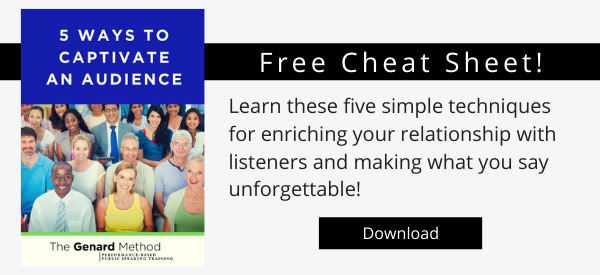Most speakers do at least an adequate job of delivering information. Yet some speakers do more, going beyond the content of their presentation to present themselves and their ideas strongly. (To get people to respond to you positively and view you the way you want them to, download my free cheat sheet "5 Secrets of Powerful Body Language.")
Questions you should ask yourself if you want to align the information you deliver with a strong presence and brand include the following:
- What self-image am I broadcasting when I speak in public?
- Am I viewed as a strong communicator?
- Does my body language support my message?
What Are You Revealing?
One of the truths about public speaking and performance is that you reveal yourself constantly and completely when you deliver presentations. That can work to your advantage if you're confident and knowledgeable. But speakers who suffer from speech anxiety, no matter how expert, can show more to audiences than they'd like to. Here are 10 action steps you can take if you have fear of public speaking.
Since people will judge you by what they see, you need to know what you're showing. Understand also that your audience's ability to trust you comes from cues that aren't language related—that in fact predate language. Many of them reside in nonverbal communication including body language. Effective movement and gestures, smiling, eye contact, and open rather than closed hand movements can predispose audience members to open up channels of communication to you or keep them closed. Read this article to become more aware of the image you're broadcasting through your body language.
Consider what facial expressions alone can convey to those you speak to:
• Recognition
• Mood
• Personality traits
• Attitude toward subject or other people
• Intention
• Trustworthiness
• Likeability
• Attractiveness
• Amusement or seriousness
• Clues to meaning
• Amplifying what is said
. . . and much more!
Understand, then, that the "Visual You" is as important as anything you say to an audience, or any of what you typically think of as your content. For when it comes to your all-important message, you are that message as much as anything else.
Why Content Isn't Enough
As a communicator, the chances are you depend too much on your content. Sheer information isn't enough to make your intention clear or to tell your listeners the action you'd like them to take. Your body language and your vocal intonation both provide important clues concerning how the information you present should be interpreted and its overall significance.
One way to help yourself give the nonverbal communication your audiences need is to remember a simple directive: Get out of your head and into your body! If you do, you'll avoid these 5 body language errors that will sink your presentation.
Learn to command space. Don't just go to the spot you'll be speaking from . . . make an entrance! Ground yourself by standing (or sitting) with feet at shoulder-width apart, so you can literally feel the earth under your feet. Move with purpose, not aimlessly. For gestures, start with your hands in the "neutral" position at your sides, and bring them up only when necessary in clean, strong, and limited movements. Most important, energize your performances so that you're not only audible but present, as though you're standing next to the person you're talking to.
Breathe with Power to Speak with Power
These aren't mysterious actions you can take as a speaker—they're necessary actions so that your passion and the excitement of your ideas come through to every listener. And they begin with a simple but important physical function: full, controlled breathing.
In other words, powerful speaking begins with powerful breathing. Breathing is not only the source of life. It’s the basis of effective body language when speaking. Stability, energy, and strength all start with effortless and sustained breath.
If you don't know how to "belly breathe," i.e., breathe diaphragmatically, you'd better learn it if you want to use body language effectively as a speaker. Here's some great information on how to do it properly. Not only will you look more confident and powerful on stage, your voice will reach the people you're trying to influence. Don't leave your listeners at the back of the room like the people in Monty Python's "Life of Brian" who heard at the Sermon on the Mount:
"Blessed are the cheesemakers."
The secrets of powerful body language for presence and effectiveness, then, are the three given above: knowledge of the visual you, commanding space, and breathing that sets the power train in motion.
Key takeaways from this blog:
- Great speakers go beyond content to present themselves strongly.
- Since people judge you by what they see, you need to know what you're showing!
- Cues that help people understand you include more than language.
- You need to command space to command your listeners' engagement.
- Powerful body language begins with the powerful breath.



